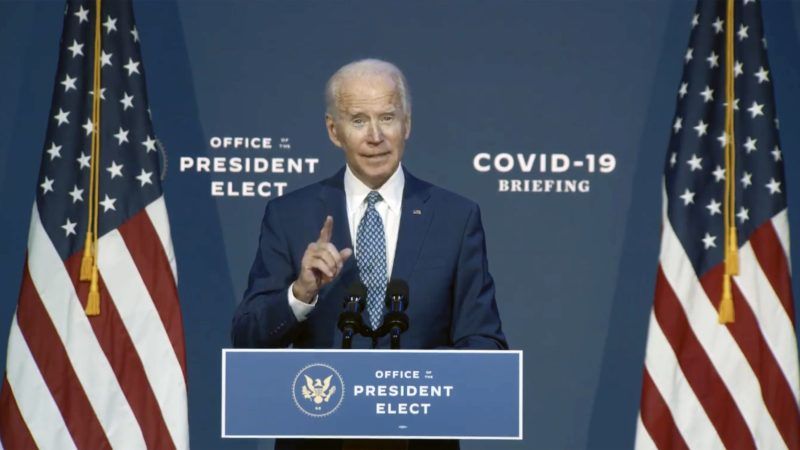Joe Biden's COVID-19 Death Forecast Looks Less Plausible Every Day
So far the president-elect's "expectation" is off by a factor of more than three, which does not bode well for his approach to the pandemic.

During a debate with Donald Trump last month, Joe Biden said "the expectation is we'll have another 200,000 Americans dead [from COVID-19] between now and the end of the year." That implied a total U.S. death toll of about 423,000 by January 1. The current total is around 242,000. Biden's projection therefore suggests that COVID-19 will kill more than 3,600 Americans a day between now and the end of the year, compared to the current seven-day average of fewer than 1,100.
That is not likely to happen. The "ensemble forecast" from the Centers for Disease Control and Prevention, based on projections from "45 modeling groups," puts the death toll at 250,000 to 266,000 by November 28. Assuming that estimate is in the right ballpark, Biden is projecting at least another 157,000 deaths from November 29 through December 31, or nearly 4,800 a day. That's more than four times the current seven-day average and more than twice the April 21 peak.
Biden's "expectation" suggests that the president-elect is not paying attention to the COVID-19 case fatality rate in the United States, which has fallen dramatically since mid-May and continues to drop. His hyperbolic warning also suggests that his election will replace a president who falsely assured us that COVID-19 was "going away" with a president who errs in the opposite direction.
That Biden was excessively pessimistic hardly means everything is just fine. Between mid-September and yesterday, according to Worldometer's numbers, the seven-day average of newly identified COVID-19 infections rose more than threefold, from about 36,000 to more than 129,000—a new record. The weekly average of daily deaths also has risen, but not by nearly as much: As of yesterday, it was up 53 percent from the recent low of about 700 on October 28 but still 52 percent lower than the peak of nearly 2,300 in April.
Since there is a median lag of about two weeks between laboratory confirmation and death, the fatal consequences of recently identified infections are not immediately apparent. But by two weeks ago, daily new cases in the United States already had risen by more than 100 percent since September 12. The increase in daily deaths has been less than half as large.
That gap is consistent with the downward trend in the case fatality rate (deaths as a share of confirmed infections), which fell from more than 6 percent on May 16 to 2.3 percent yesterday—a 62 percent drop. The trend probably has been driven by several factors, including ramped-up testing that identifies milder cases, a younger and healthier mix of patients, and improved treatment. But the upshot is that increases in deaths are not commensurate with increases in cases, even allowing for the lag between the two indicators.
Given the ongoing rise in daily new cases, we can expect the daily death toll to continue going up as well, although not by nearly as much as Biden anticipated. That much should have been apparent from the experience with this summer's infection spike, which did not lead to a proportional spike in deaths.
The fact that Biden predicted more than three times as many daily COVID-19 deaths as we are currently seeing does not bode well for his approach to the pandemic. All government interventions aimed at curtailing infections, ranging from mask mandates to lockdowns, have costs. Those costs need to be weighed against the likely benefits, which depend on what would have happened otherwise. Biden's scaremongering puts a big thumb on one side of the scale.